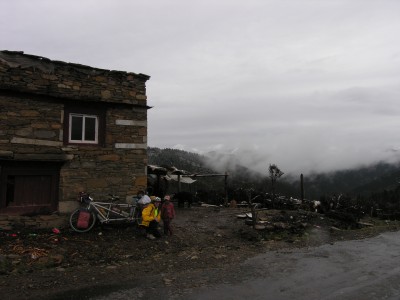
- Shelter
We made quick work of a 7,000 ft climb to a 15,252 ft. plus pass, and were feeling pretty chipper considering the troubles other cyclists had encountered with the steep grades and high elevations. (See the last post) Our regular climbs of Mt. Lemmon (close to 9,000 feet elevation) in Tucson, had prepared our legs well, and we took enough off days for good acclimatization. After a nearly two weeks of our legs getting accustomed to the 80 pounds our so we carry, the climb was not as difficult as expected.
However, rather than the long descent to lower elevation for rest and a decent camp spot, we found the road stayed high, rolling up and down 1,000 feet or so as the weather deteriorated to rain, wind and sleet, and then climbing again, finally snow. We knew that a night of rest at lower elevation would be essential for the next pass of 15,475 feet, but there was no down to be had.
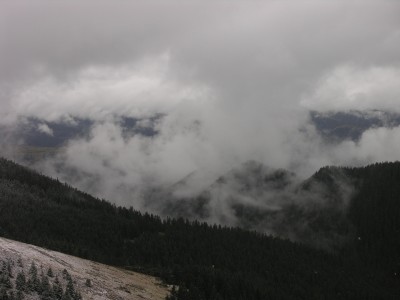
- Staying High
We stayed high as the clouds lowered and the sky darkened. We were shivering from the wet and cold and the effort of the pass. We knew we had to find shelter, high altitude or not, and hope our light sleeping bag would be enough. We failed to find a flat spot; this is called the Tibetan plateau, but it is riddled with 1,000 to 2,000 foot mountains with steep gorges and very few spots flat enough for a tent. Just as we were about to give up and camp beside the road (not something we do unless in dire circumstances) we saw a Tibetan settlement, and decided to see if we could at least get water. We were low and there was only some snow to eat, and maybe find a place behind a house out of sight. We would have to sleep at well over 14,000 feet, but we needed shelter.

- Warmth and Food
As we rolled up to a small stone house/barn, an older looking woman smiled at us and made the international sleeping sign: prayer hands laid next to her head bent sideways. Nothing ever looked so good to us. A young woman, whom we took to be her daughter, and her child were in their small barnyard with their small herd of yaks preparing for milking.
She motioned for us to bring Zippy into the house, which was on the bottom level, the barn. We leaned him up against the stone wall, unloaded our bags and followed grandma (we’ll never know her name) upstairs. Their living quarters was one large room with a small hearth and a cozy fire. There was not a chimney, but a stovepipe reached just as far as a roof hatch, and the space was filled with a blue haze of smoke that softened all shapes and colors.

- Home for the Night
The floor was rough cut slabs and the roof was supported by large log beams, but in the stone walls were set modern aluminum windows with latches. Various food items were drying on feed sack material and the beds were rolled up in one corner along with corn husk pillows. The hearth held all the pans they owned, and all the cooking was done on top of the fire. The daughter hurried up from her milking to prepare our meal and grandma sat and smiled at us and attempted to communicate. She knew no Chinese, only Tibetan, and our communication was by pantomime.
First, we were served a liquid from a pot that seemed to have a permanent spot on the hearth. It was yak butter tea. It’s pretty much as its name describes: water, yak butter (lots), and a few tiny leaves of tea. Now this sounds awful, but we found it quite good, and warming after a trying day.
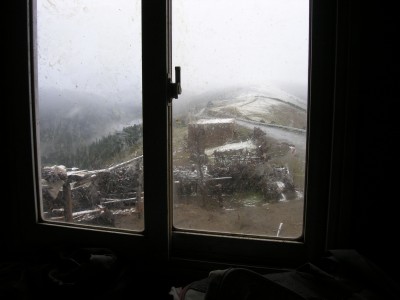
- Snowy Morning
Our first course was a white crumbly substance that Claire likened to the curds we had in Wisconsin, only they didn’t squeak in your teeth as much and had a very fermented flavor. I looked over and I could see a large pile of what we were eating drying/fermenting on the floor near where we would probably sleep. We ate from a communal bowl, grandma first, showing us how with the fingers of her right hand (this is important to remember). We are not prone to insulting the hostess, so we imitated her. We both liked the unusual texture and fermented flavor. I could see uses for it in other genres of cooking.
Grandma prepared the next course while the daughter finished milking. She sliced potatoes French Fry style and fried them in a huge amount of an unidentified oil poured from a large plastic container stuffed with a rag. Then she added some water for a steamed finish. This was served with rice, and more yak butter tea. It was quite satisfying, and enjoyed with the company of a Buddhist monk who’d dropped in for a meal. Apparently you feed a monk when he shows up at your door, anytime.
After dinner, and another couple of rounds of yak tea, we both needed to relieve ourselves of some liquid, and asked (don’t ask how we asked) for the toilet, which we expected to be a short-drop, i.e. a shallow pit with weather shelter over it. Not here. We were pointed to the guardrail and over the hill to the village toilet. It wasn’t as bad as you might think. Such places in America are littered with toilet paper, the white of which announces each deposit. Here they do not use toilet paper. Remember how all the eating and touching of food is done with the right hand? Yep.
The next morning, just at first light Claire and I both felt a need and headed past the sleepy yaks, over the guardrail where we each found – recently at least – an unused bush. It had snowed overnight and we had two inches of something much better than toilet paper to use. Chilly, but refreshing.
During the night we slept like the family, fully clothed on the floor on light pads with husk filled pillows. We went to sleep to the sound of grandma reciting her prayers on her prayer beads. Breakfast was – guess what – yak butter tea, leftover potatoes and rice, and an addition – yak butter rolled in a mixture of rough meal and some sugar. Again, strange sounding, but good and filling. The little girl of three or so got her breakfast from mom, two teats worth.
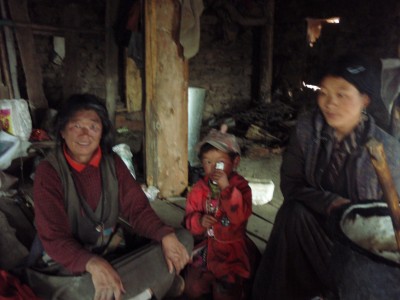
- Friends
It sounds romantic: going to sleep to the sounds of chanting and waking to the sounds of milking. But these women’s lives are a gritty existence that our culture hasn’t known for generations. Hauling wood, water, and food up the ladder to the living space, making butter and curds, grinding grain, hand washing clothes, keeping the fire going, cooking… Mundane, routine, weather-dependent, smoke-filled and layered with years of grime. At first, we were both a little uncomfortable with their aboriginal way of life (we even took some Pepto-Bismol as a prophylaxis against any reaction to the yak butter). It’s kind of like going feral in Australia, at first, you try to avoid the bull dust, then you live with it, until finally it becomes your outer layer.
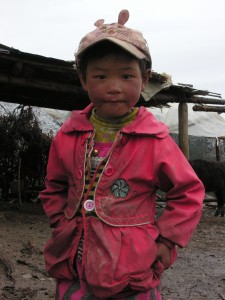
- Wonder What She Thought of Us
The five tiny calves at the bottom of the ladder were the future for these women. Their house was smaller than most in the village. I wondered where the men were? What would the little girl’s life be like? Would she get an education? Would she look at that post card of the horse those people on the bicycle gave her and realize someday what a big world this is? We used Bob’s jacket printed with a map of the world on it to try to convey where we were from, where we’d been and where we planned to go. I have no idea if they’d ever seen a map before. It doesn’t really matter to them, their world is an isolated village along a road between two passes and 50 kilometers from the nearest town. An occasional bicyclist may pass by their house or ask for shelter. To us, these women will always be a part of our world, and I don’t ever want to forget them.
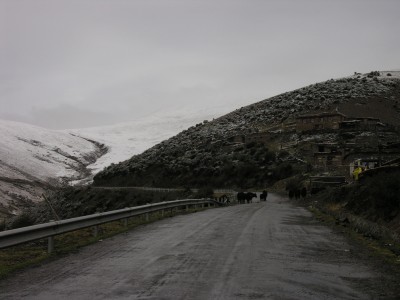
- What lies ahead as the yaks are put out to pasture.
The Road To Shangri-la is not always what is expected.

Claire Rogers writes on cross-cultural adventure drawn from her travels across the Silk Road from Beijing to Istanbul, around Australia and of course, through Iceland–all by bike.
She’s currently traveling by tandem with her husband Bob, through southwest China, Laos, Vietnam, Cambodia and Thailand. Check out NewBohemians.net for more information on their travels.








